Collectors and mushroom lovers to go out in search of that rare species of mushroom. But how do you know which one is poisonous and which one isn’t?
Well, the most important thing to know about poisonous mushrooms is that they always appear to be beautiful and appealing.
The toxins that make up the poisonous compounds in poisonous mushrooms are called amatoxins and orellanin.
They are primarily found in the stem of the mushroom, but can also be present in the fleshy cap as well as under its skin or on its grills. The toxins can cause vomiting, diarrhea and even death if ingested by humans or animals.
In this article, we’re going to look at the most poisonous mushrooms found in North America with their identifying characteristics.
How Do You Identify Poisonous Mushroom?
While there are many species of poisonous mushrooms, there are also several key characteristics and techniques that can help you identify them:
Know the Common Toxic Species
Familiarize yourself with the most common poisonous mushrooms in your region by consulting field guides or joining a local mycological club.
Study Mushroom Features
- Cap Characteristics: Examine the cap’s size, color, shape, and texture. Some poisonous mushrooms have features like warts or scales, while others may appear smooth or slimy.
- Gills or Pores: Observe the gills (thin, blade-like structures) or pores (small holes) underneath the cap. Note their color, spacing, and attachment to the stem. If the gills have a strange color and you don’t know the variety of mushroom with certainty, leave it. Also, changes in color when bruised or cut can be sign that it is poisonous.
- Stem Characteristics: Pay attention to the stem’s height, thickness, color, and any other features like a ring or volva (a cup-like structure at the base). The presence of a volva, especially if it has a colored ring, is typically a sign of a poisonous variety. So, dig around the base of your mushroom before picking.
- Spore Print: Taking a spore print can be a valuable identification tool. Place the cap, gills down, on a white piece of paper for a few hours to overnight. The color of the spore deposit can help narrow down the species.
Consider the Habitat
Different mushroom species thrive in specific environments. Knowing where you found the mushroom (e.g., in woods, grasslands, near certain trees) can provide clues about its identity.
Strange Odor
Most edible mushrooms will have a pleasant earthy aroma. Poisonous varieties tend to have an acrid, chemical or strange odor. Leave anything that doesn’t smell distinctly mushroom-like.
Observe Changes Over Time
Some mushrooms change in appearance as they mature. It’s important to observe a mushroom at different stages of its growth to get a more accurate identification.
Consult Multiple Resources
Cross-reference information from multiple reliable sources, such as field guides, reputable websites, and experienced mycologists. Online forums and local mycological clubs can also be excellent resources for getting identification assistance.
Color on Cap or Stem
Not all red, orange, pink or green mushrooms are poisonous, but many of them are. Again if you aren’t sure about the mushroom in question, don’t take it home.
While color can be an important factor, it’s not always a definitive indicator of a mushroom’s edibility. Toxic mushrooms can mimic edible ones in terms of color, so it’s crucial to consider all characteristics.
Err on the Side of Caution
If you’re uncertain about the identification of a mushroom, do not consume it. Even experienced foragers make mistakes, and the consequences of consuming a toxic mushroom can be severe.
Learn from Experts
If you’re serious about mushroom foraging, consider taking classes or going on forays with experienced mycologists. Learning from experts in the field can significantly enhance your knowledge and safety.
List of Poisonous Mushrooms
Here’s a list of some of the most poisonous mushrooms in North America:
- Death Cap
- Webcaps
- Autumn Skullcap/funeral bell
- Destroying Angels
- Poison Fire Coral
- Deadly Dapperling
- Conocybe filaris
- Fool’s webcap
- Panther cap
- Angel’s wings
- Chestnut Dapperling
- Red fly agaric
- Brown Roll-rim
Death Cap Mushroom
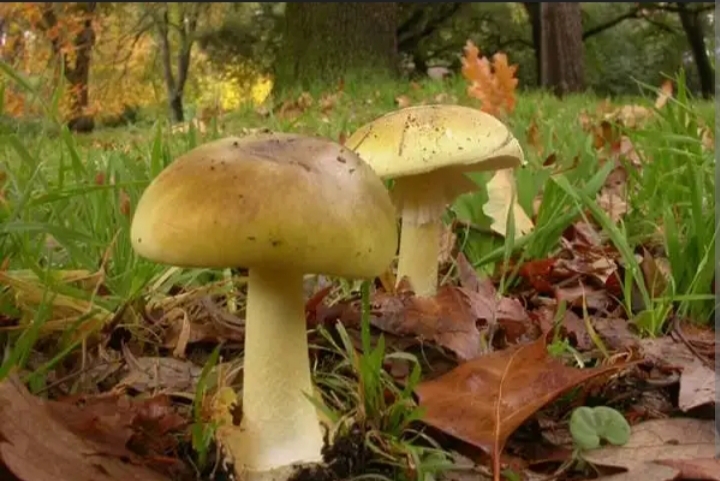
Scientific Name: Amanita phalloides
Fruitbody Color: Shiny olive-yellow to greenish-bronze
The death cap mushroom is a common mushroom found in Europe and North America. The name ‘’death cap’’ comes from its distinctive shape and color, which often resemble a skull.
It can be found in woodlands, fields, pastures and gardens. It is very dangerous to eat and can cause death if eaten in large amounts.
This mushroom grows in clusters and has a greenish cap with a white stripe. The cap color can also be white, olive-green, bronze or brown with spots.
The underside of the cap has white gills that are attached to the stem. It smells honey-sweet and rancid when old, though sometimes it’s virtually odorless.
Webcaps Mushroom
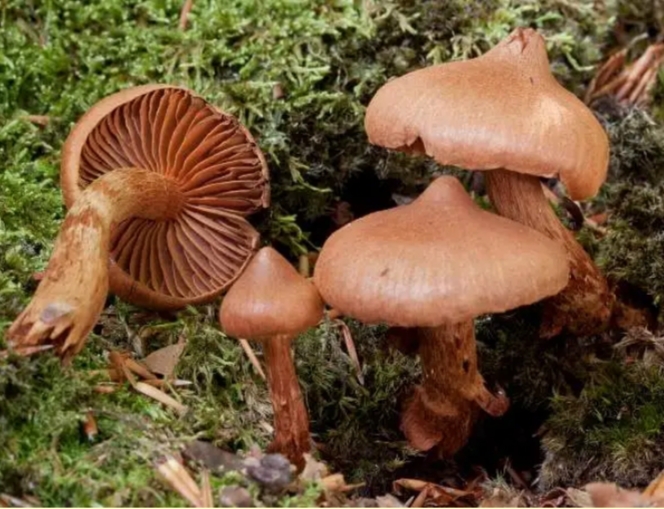
Scientific Name: Cortinarius rubellus
Fruit body Color: Tan to Brown
Also referred to as deadly webcap is fairly rare but deadly poisonous mushroom commonly found in Europe, Asia and North America including the Southeast United States.
It found from late summer to early winter in a variety of habitats such as woodlands, fields, meadows or at the base of trees.
The deadly webcap grows up to 6 inches tall, with the cap ranging between 1 to 3 inches in diameter. The cap is brown in its initial stages then turns tan-brown at its final stage of growth.
The flesh is cream or pale yellow but more rusty brown in the stem base. It generally has a radish-like smell, though not that strong.
Also Read: Different Types of Yellow Apples
Autumn Skullcap/funeral bell
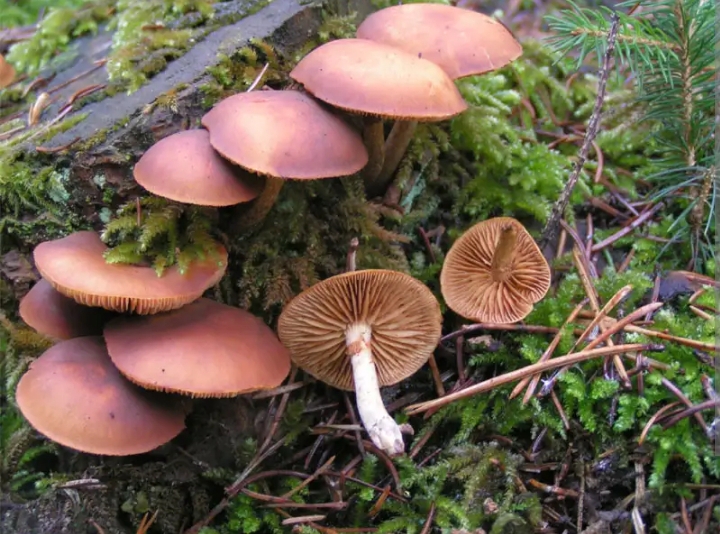
Scientific Name: Galerina marginata
Other Names: Funeral bell, Deadly skullcap
Fruit body Color: Brown-yellow
The Autumn Skullcap mushroom can be found in almost any climate. It’s one of the most widely distributed mushrooms in North America, found all along from the Pacific Northwest to New England to Florida, California all the way to Canada.
It is a wood-rotting fungus that grows on decaying woodchips or mulch at the base of trees or shrubs during summer or fall season.
The fruit body of this mushroom has brown to yellow-brown caps that fade in color when dying. As the cap grows and expands, it becomes broadly convex and the flattened measuring about 2 to 3 inches in diameter.
The gills are brownish and give a rusty spore print. The Autumn skullcap has a mildly earthy smell with a hint of sweetness and a musky odor.
Destroying Angels
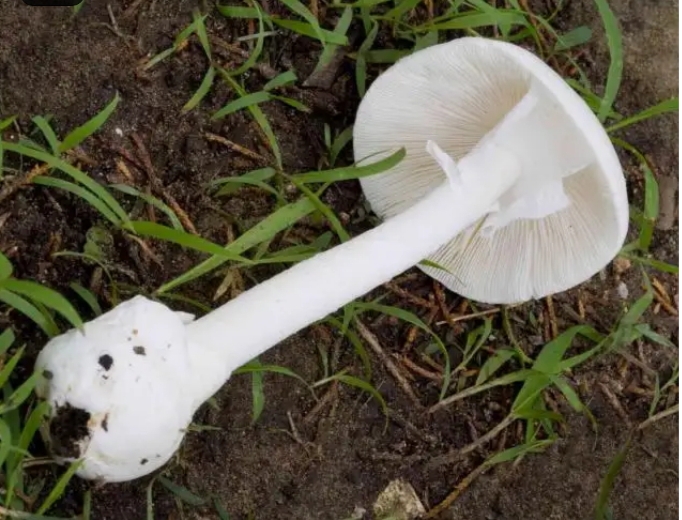
Scientific Name: Amanita verna
Other Names: Fool’s mushroom
Fruit body color: Pure White
Destroying mushroom is a type mushroom that that can be found throughout Europe, Asia and North America. You can also find it in Australia and New Zealand.
This mushroom has a distinctive appearance and can be found growing on trees, rocks and sometimes in lowland soils. In these areas, it is often found in groups and often grow in clusters. Its color ranges from cream to pure white.
The stalk and gills are white whereas the cap can be pure white or white at the edge and yellowish or tan at the center. The gills on the underside of the cap are curved outward and attached to thick fleshy stalks.
Poison Fire Coral
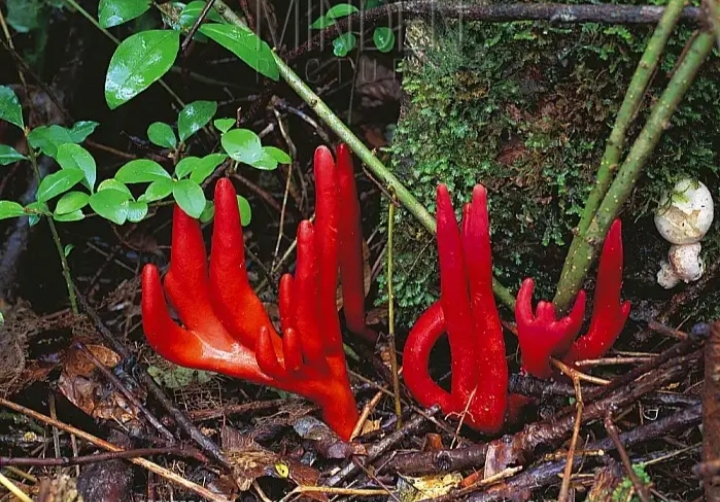
Scientific Name: Podostroma cornu-damae
Fruit Body Color: Red
Poisonous fire coral mushroom is native to Asia (Japan & Korea); and can be found in forests and Jungles throughout the world.
The mushroom commonly grow in tropical environments or those with high humidity levels including Australia, Indonesia, Hawaii, Florida and some parts of Mexico.
It is considered to be a deadly poisonous mushroom and can create extreme hallucinations and even death if it is ingested.
Its color varies from pink to red-orange with some specimen having a pure red color. Their surfaces are almost smooth, but sometimes appearing very faintly roughened when you observe it with a microscope.
Deadly Dapperling
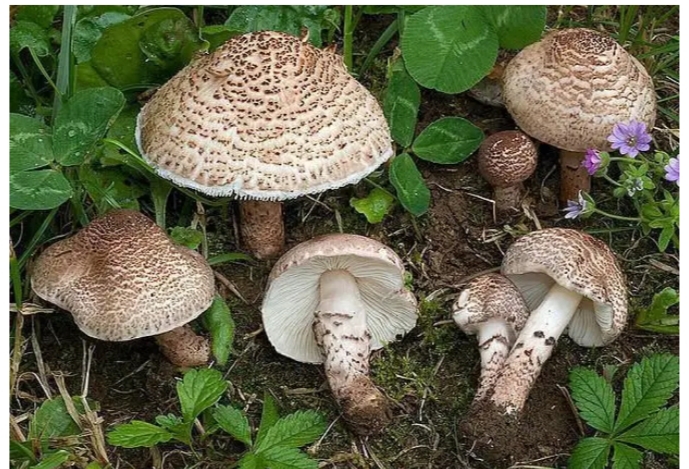
Scientific Name: Lepiota brunneoincarnata
Fruit Body Color: Red-brown at initial stages of growth and dark brown when fully grown
The Deadly Dapperling mushroom is a deadly poisonous mushroom that grows in the forests of Europe, North America and temperate regions of Asia.
It also grows in grassy areas such as fields, parks and gardens, and is often mistaken for edible mushrooms. Sometimes it can also be found on dead trees or on trunks of living trees.
The mushroom has a brown scaly cap with a pinkish brown stem and white gills. In other words, the upper part of the stem is pinkish tan while the lower part is covered in dark brown scales. They are separated by a dark brown ring-like zone.
The thick flesh reddens on bruising or cutting and smells like unripe fruit. The deadly poison of this mushroom can kill if ingested in large quantities or amounts.
Conocybe filaris
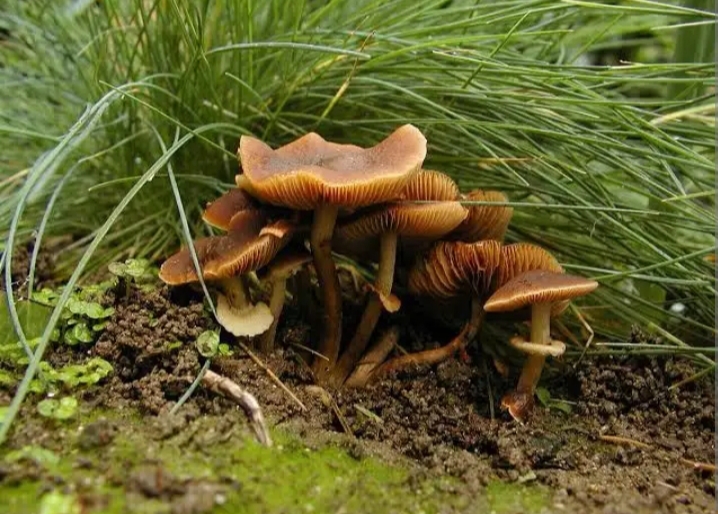
Common Name: Conocybe mushroom
Scientific Name: Pholiotina rugosa
Fruit body Color: Rusty brown
Conocybe filaris, known commonly as the conocybe mushroom is a common mushroom which is widely distributed in very many places in Europe, Australia, Asia and North America.
It commonly grows in clusters in lawns, woodchips, yards, flowerbeds and mulch. The most distinctive characteristics of this mushroom is its rusty brown color and the conical cap that expands to flat, usually with an umbo.
The mushroom has a striated margin, smooth brownish top and gills. The cap is about 3 to 5 centimeters wide and a stem that’s about 1 to 2 centimeters long. The stalk also features a prominent and movable ring. The spores are rusty brown and, in most cases, you need a microscope to identify this species.
Also Read: Different Types of Yellow Peppers
Fool’s webcap mushroom

Scientific Name: Cortinarius orellanus
Other Names: Fools webcap, fool’s webcap
Fool’s webcap is common in the woods and forests of Western North America, Europe and Asia. It is most common where there are trees especially pine trees and grass.
The fool’s webcap mushroom looks like a top hat when it is small, but once the mushroom grows larger, it expands into an umbrella shape.
The cap is orange-brown in color and is covered in fine, fibrous scales but becomes smooth with age. The thick gills are light-brown, changing to rusty-brown as time goes by.
The fruit body smells slightly of radishes when cut and has no strong taste. This mushroom is poisonous if ingested and causes nausea and vomiting if eaten in large quantities.
Panther cap Mushroom
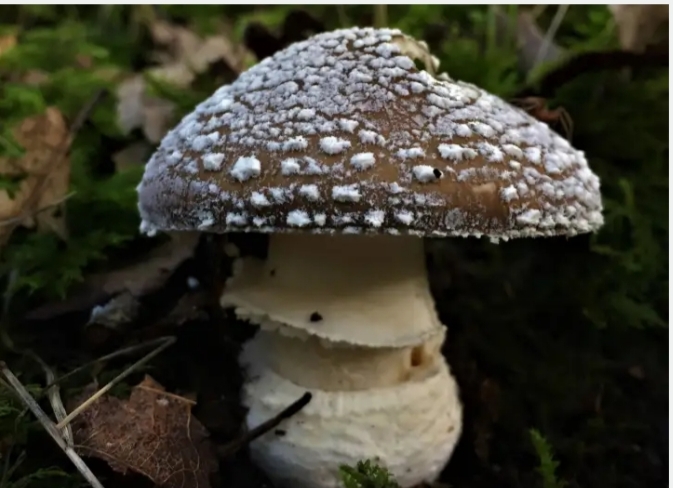
Scientific Name: Amanita pantherine
Other Names: False blusher
Fruiting Body Color: Brown
The Panther cap mushroom is a very rare mushroom that grows in the woodlands of North America and Europe. It is commonly found under trees, logs and stumps.
It has a distinct, round shape with a cap that ranges in color from hazel-brown to pale brown. The top of the cap is covered with easily removable pure white or sordid cream spots or warts.
The underside of this mushroom is often white due to its spores being exposed during growth. The gills are attached to the stem by an elastic cord that stretches when the mushroom expands or contracts.
They are white in color but they may turn gray when they are bruised or injured. This mushroom produces an unpleasant smell reminiscent of raw potatoes.
The mushroom is known to be poisonous, with symptoms including vomiting, diarrhea and stomach cramps.
Also Read: Hillbilly Tomato Facts
Angel wings Mushroom
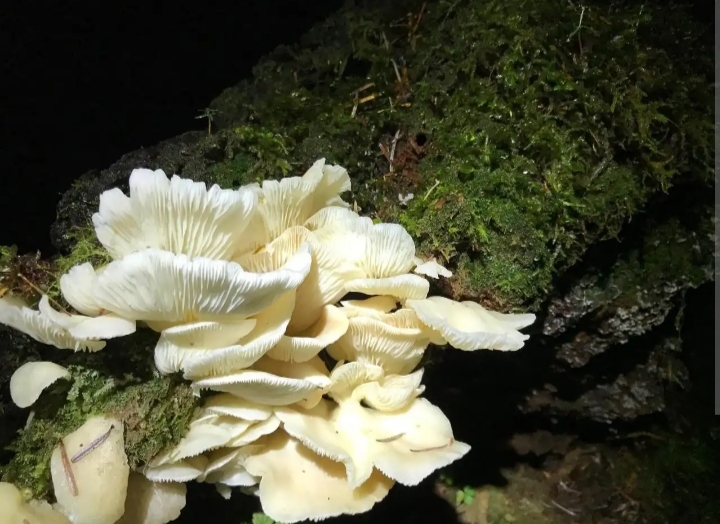
Scientific Name: Pleurocybella porrigens
Fruiting Body Color: Pure white to cream white
The Angel wings mushroom often grows on the ground in areas with lots of rain. You can also find it along the edges of forests and around wetlands such as near streams or rivers.
The Angel wings mushroom has a large fruiting body up to 5 cm wide. The body is pure white or cream colored but with time form a tinge of yellow.
The stripe is either very short or completely absent and the flesh has a faint but pleasant smell. It is referred to as Angel wings because you can see the mushroom sticking out from the ground like angel wings would.
If you eat this mushroom, you’ll find yourself extremely thirsty and nauseous. Your eyes will begin to itch and might as well develop a rash on your face skin.
Chestnut dapperling Mushroom

Scientific Name: Lepiota castanea
Fruiting Body Color: Brownish red
The chestnut dapperling is a mushroom that grows in the fall and winter. It grows in groups and is found in many forests around the world including those of the eastern part of the United States.
It is also often found in areas where there are many dead trees or logs lying around. The mushroom is named chestnut dapperling because it’s shaped like a chestnut i.e shaped like a small cone with a point on top. It has a long chestnut brown stem and its cap is covered in small bumps.
The underside of the cap has white gills that run across its length and help to form the mushroom’s shape. The color of this mushroom ranges from tan to brownish-red.
The mushroom feature rings which in larger mushrooms are detachable and glide up and down the stem.
This mushroom smells like earthy soil when bruised. The poison in this mushroom can cause nausea, vomiting, diarrhea, acidosis (too much acid in the blood) and muscle pain.
Also Read: Different Types of Yellow Pepper
Red fly agaric mushroom
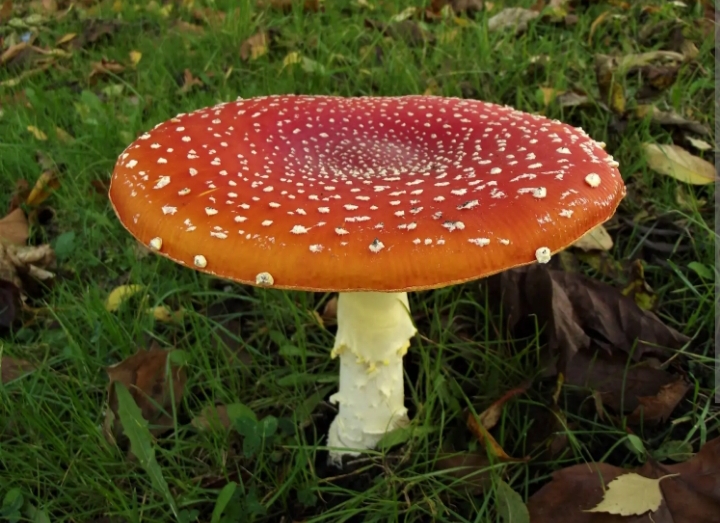
Scientific Name: Amanita muscaria
Other Names: Fly amanita, muscimol mushroom, red toadstool
Fruiting body color: Cream white
A red fly agaric mushroom is a poisonous that grows in many places around the world including United States and Canada.
It is often found on the ground, under pine trees or deciduous trees and in open areas or woodland trails. This mushroom is common between May and September, though it can also be found during other seasons. The red agaric mushroom has a bright red cap that is covered with white warts.
The stem is white or creamy white in color and can range in length from 2 to 4 inches long. This mushroom has no gills under its cap; instead its spores are distributed through pores on its underside.
The poison in this mushroom has been reported to cause hallucinations, muscle pain, cramps, diarrhea and allergic reactions. The symptoms are severe when ingested in large amounts.
Also Read: Vines That Grow On Trees
Brown Roll-rim Mushroom

Scientific Name: Paxillus involutus
Fruiting Body Color: Brown
The brown roll-rim mushroom is a brown, funnel-shaped fungus that grows either solitary or in clusters on the ground.
It is widely common in many places across the Northern Hemisphere including United States and Mexico. It has a rough texture and its color ranges from dark brown to light brown.
The cap can be between 4 to 5 cm in diameter and it is covered in small bumps or ridges that give a scaly appearance. The cap surface is initially downy and later smooth, becoming sticky when wet.
The narrow brownish yellow gills are decurrent and forked and can be peeled easily from the flesh. The mushroom darkens when bruised and older specimens may have darkish patches.
The spores germinate and produce more spores which upon landing on the soil continue their life cycle.
Common Misconceptions About Poisonous Mushrooms
Misconceptions about poisonous mushrooms can be dangerous, as they may lead people to make risky decisions when foraging or handling wild mushrooms.
All Poisonous Mushrooms Are Brightly Colored
While some poisonous mushrooms are brightly colored, not all are. Poisonous species can be white, brown, or even have earthy tones that might make them look similar to edible mushrooms. Color alone is not a reliable indicator of toxicity.
Cooking Destroys Toxins in All Poisonous Mushrooms
Cooking can reduce the toxicity of some mushrooms, but not all. The toxins in certain mushrooms, such as the Amanita species (like the Death Cap), are heat-stable and can remain dangerous even after thorough cooking. Eating raw or undercooked toxic mushrooms can still lead to poisoning.
Edible Mushrooms Can Turn Toxic When Consumed with Alcohol
While there are mushrooms, like Coprinopsis atramentaria (Inky Cap), that can cause adverse reactions when consumed with alcohol, this is relatively rare. It’s not a general rule that applies to all edible mushrooms.
A Taste Test Can Identify Edible Mushrooms
Tasting a small amount of a mushroom to determine its edibility is extremely risky and should never be done. The taste of a mushroom is not a reliable indicator of its toxicity, as some deadly mushrooms can taste pleasant or even spicy.
Only Wild Mushrooms Are Poisonous
Many people assume that cultivated or store-bought mushrooms are safe while only wild mushrooms are toxic. This is not true. While commercially cultivated mushrooms are generally safe to eat, some wild edible mushrooms can be mistaken for their toxic counterparts, leading to poisoning if not identified correctly.
All Poisonous Mushrooms Are Lethal
Not all poisonous mushrooms are deadly, but they can still cause serious illness and health complications. Some toxic mushrooms may lead to gastrointestinal distress, organ damage, or long-term health issues rather than immediate death.
Only Novices Get Poisoned
Poisoning from mushrooms can happen to anyone, regardless of their level of experience. Even experienced foragers can make mistakes, especially when identifying mushrooms with similar edible counterparts.
Peeling the Skin Off Mushrooms Makes Them Safe
Removing the skin or outer layer of a mushroom does not necessarily remove all toxins. Some mushrooms contain toxins throughout their entire structure, and peeling may not make them safe to eat.
If Animals Eat a Mushroom, It Must Be Safe for Humans
This is a dangerous assumption. Many animals have different digestive systems and tolerance levels for toxins compared to humans. What is safe for one species may be harmful to another.
Smelling a Mushroom Can Determine Edibility
While the odor of a mushroom can provide some clues about its identity, it’s not a definitive indicator of edibility. Toxic mushrooms can sometimes have an appealing aroma, while edible ones may lack a strong scent.